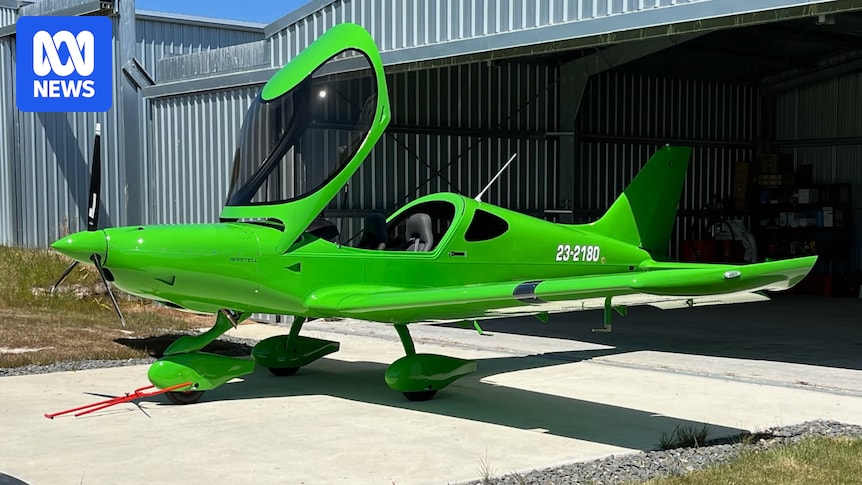It was a mild day on the northern Tasmanian coast when a couple and their dog climbed into a small green airplane and flew away.
But alarms sounded when pilot Gregory Vaughan, 72, his partner, Kim Worner, 66, and their dog, Molly, failed to arrive at their destination in central New South Wales four hours later.
Despite an extensive search across Bass Strait and nearby islands, there has been no trace of the missing trio or their plane since the Saturday flight a week ago.
It has left many questioning how, in 2025, an aircraft and its occupants can simply disappear.
The missing two-seater Bristell S-LSA plane is a distinctive green. (Supplied: Tasmania Police)
What do we know?
Last Saturday at 12:45pm, Mr Vaughan and Ms Worner departed from George Town airport, about an hour north of their home in Deloraine, in a two-seater Bristell S-LSA plane purchased a few months earlier.
They were due to make a fuel stop in regional Victoria, before continuing to Hillston in New South Wales, west of Condobolin.
George Town Airport Association president David Brewster said Mr Vaughan had been planning the journey for some time and texted a friend before leaving, telling him he was all set to go.
Friends of couple missing in light plane alerted by lack of radio call
But Mr Brewster said the friend sensed trouble when Mr Vaughan’s departure time came and went without a departure call being heard on the radio.
Mr Brewster said he and the friend contacted Airservices Australia at about 1:15pm, after noting the plane had left the airport.
They then prepared their own planes to conduct a search for Mr Vaughan’s aircraft.
The formal alarm was raised by a family member after 5pm, when the travellers failed to land at Hillston airport.
An official aerial and marine search began soon afterwards.
The flight path of an AMSA Challenger jet during the search effort. (FlightRadar24)
Police said Mr Vaughan had not made a distress call and believed there were no active tracking devices on board.
Australian Maritime Safety Authority (AMSA) said the pilot made no contact with authorities during the flight.
“The best-case scenario we can only really hope for is they have made land somewhere,” Tasmania Police Inspector Nick Clark said on Tuesday.
The search effort has involved helicopters, fixed-wing aircraft as well as ships, including for a time the Spirit of Tasmania ferry. (Supplied: Tasmania Police)
What are the rules for private pilots?
Wynyard Aero Club president David McCarthy said that unless entering controlled airspace, there was no requirement for private or recreational pilots to log their flight plans, make radio calls to air traffic controllers during a flight or have a transponder.
In aviation, transponders — a radar-dependent surveillance device — play a vital role in identifying aircraft to air traffic control and other aircraft.
“With what we call ‘visual flight rules’, which is how most private pilots fly, you don’t need to put a flight plan in,” Mr McCarthy said.
“But you should at least notify a responsible person of where you’re going and when you’re expected back.”
Mr McCarthy says in most cases, a flight plan does not need to be submitted. (Supplied: David McCarthy)
He said pilots could also nominate a SARTIME (time search action required) with Airservices Australia, which is when search and rescue procedures should be initiated, if the aircraft fails to check in.
A Civil Aviation Services Authority (CASA) spokesperson said when flying long distances over water, pilots were required to leave a flight note with a responsible person, or notify authorities through a flight plan or SARTIME.
Mr McCarthy said it would be “highly unusual” for an experienced pilot not to make any calls.
Loading…What about tracking devices?
Modern aircraft are typically fitted with devices that help track them, such as Automatic Dependent Surveillance-Broadcast (ADS-B) or a transponder, but no signal appears to have been picked up by Mr Vaughan’s plane on flight radar maps.
CASA rules state private or recreational pilots must carry a registered distress beacon when flying more than 50 nautical miles (93 kilometres) from land.
Bass Strait at its narrowest point is about 220 nautical miles wide.
Recreational Aviation Australia chair Michael Monck said pilots “should carry life jackets and appropriate sort of safety equipment”.
Mr Monck says recreational pilots undertake extensive training. (Supplied: Michael Monck)
Mr Monck confirmed satellite trackers were not required in any type of airspace.
He said transponders were only required in some controlled airspaces.
Should the rules be reviewed?
Mr McCarthy and Mr Monck fear increased regulation would add to costs and detract from the joy of flying.
They said aviation was generally incredibly safe.
“I’m not sure there would be a commensurate increase in safety associated with that bureaucratic sort of red tape,” Mr Monck said.
Police are “still hoping for a positive outcome” as they continue to scour Tasmania’s north and north-eastern coastline for the missing plane. (Supplied: Tasmania Police)
Mr McCarthy said pilots underwent substantial training.
In addition, he said most private pilots performed a flight review with an instructor every two years.
“The most dangerous time for me flying is actually driving to the airport,” he said.
“Once I’m in the air, I’m in a much safer environment because of the way that it operates and the way that we’re trained.”
But there would always be a certain level of risk.
“The bottom line [is] things can go wrong,” he said.
Loading…

